Implemente la segmentación de superposición protegida BGP EVPN en los switches Catalyst serie 9000
Opciones de descarga
-
ePub (1.0 MB)
Visualice en diferentes aplicaciones en iPhone, iPad, Android, Sony Reader o Windows Phone -
Mobi (Kindle) (958.6 KB)
Visualice en dispositivo Kindle o aplicación Kindle en múltiples dispositivos
Lenguaje no discriminatorio
El conjunto de documentos para este producto aspira al uso de un lenguaje no discriminatorio. A los fines de esta documentación, "no discriminatorio" se refiere al lenguaje que no implica discriminación por motivos de edad, discapacidad, género, identidad de raza, identidad étnica, orientación sexual, nivel socioeconómico e interseccionalidad. Puede haber excepciones en la documentación debido al lenguaje que se encuentra ya en las interfaces de usuario del software del producto, el lenguaje utilizado en función de la documentación de la RFP o el lenguaje utilizado por un producto de terceros al que se hace referencia. Obtenga más información sobre cómo Cisco utiliza el lenguaje inclusivo.
Acerca de esta traducción
Cisco ha traducido este documento combinando la traducción automática y los recursos humanos a fin de ofrecer a nuestros usuarios en todo el mundo contenido en su propio idioma. Tenga en cuenta que incluso la mejor traducción automática podría no ser tan precisa como la proporcionada por un traductor profesional. Cisco Systems, Inc. no asume ninguna responsabilidad por la precisión de estas traducciones y recomienda remitirse siempre al documento original escrito en inglés (insertar vínculo URL).
Contenido
Introducción
Este documento describe cómo implementar BGP EVPN VXLAN Protected Overlay Segmentation en Catalyst 9000 Series Switches.
Prerequisites
Requirements
Cisco recomienda que tenga conocimiento sobre estos temas:
- Conceptos de BGP EVPN VxLAN
- Troubleshooting de BGP EVPN Unicast
- política de ruteo BGP EVPN VxLAN
Componentes Utilizados
La información que contiene este documento se basa en las siguientes versiones de software y hardware.
- Catalyst 9300
- Catalyst 9400
- Catalyst 9500
- Catalyst 9600
- Cisco IOS® XE 17.12.1 y versiones posteriores
La información que contiene este documento se creó a partir de los dispositivos en un ambiente de laboratorio específico. Todos los dispositivos que se utilizan en este documento se pusieron en funcionamiento con una configuración verificada (predeterminada). Si tiene una red en vivo, asegúrese de entender el posible impacto de cualquier comando.
Antecedentes
Descripción de características de alto nivel
La función de segmento protegido es una medida de seguridad que impide que los puertos se reenvíen tráfico entre sí, incluso si se encuentran en la misma VLAN y el mismo switch
- Esta función es similar a las VLAN 'switchport protected' o privadas, pero para fabrics EVPN.
- Este diseño fuerza todo el tráfico al CGW, donde un firewall puede inspeccionarlo antes de enviarlo a su destino final.
- Los flujos de tráfico son controlados, previsibles y fáciles de inspeccionar mediante un dispositivo de seguridad centralizado.
Detalles del documento
Este documento es parte 2 o 3 documentos interrelacionados:
- Documento 1: La Implementación de la Política de Ruteo BGP EVPN en los Catalyst 9000 Series Switches cubre cómo controlar el tráfico BGP BUM en la Superposición, y debe configurarse primero
- Documento 2: Este documento. A partir del diseño y la política de superposición del documento 1, este documento describe la implementación de la palabra clave 'protected'
- Documento 3:Implementación de Retransmisión DHCP de Capa 2 de BGP EVPN en Switches Catalyst de la Serie 9000 cubre cómo funciona el relé DHCP en un VTEP solo de L2

Precaución: Debe implementar la configuración del documento 1 antes de implementar configuraciones de segmentos protegidos.
Tipos de segmentos protegidos
Totalmente aislado
- Permite únicamente la comunicación de norte a sur y
- La puerta de enlace se anuncia en el fabric con la CLI 'default-gateway advertise'
Principalmente aislado
- Permite la comunicación de norte a sur (en este caso de uso, se permiten los flujos de tráfico de este y oeste en función de las políticas de tráfico del firewall).
- Permite la comunicación de Este a Oeste (basada en las políticas de tráfico del firewall)
- La puerta de enlace es externa al fabric y la SVI no se anuncia mediante la CLI 'default-gateway advertise'
Comportamiento del switch
- Los hosts no pueden comunicarse entre sí directamente aunque estén conectados al mismo switch (solicitud ARP no enviada a otros puertos en el mismo switch cuando los hosts están en el mismo VRF/Vlan/Segmento)
- Sin tráfico BUM entre VTEP L2 (prefijos IMET filtrados mediante la configuración de política de routing)
- Todos los paquetes de los hosts se retransmiten a Border Leaf para ser reenviados. (Esto significa que para que el Host 1 se comunique con el Host 2 en la misma hoja, el tráfico está anclado al CGW)
Manejo de Tipo de Ruta 2
- Las hojas de acceso anuncian RT2 local con la Comunidad ampliada del árbol E y el indicador de hoja configurado
- Los Hojas de acceso no instalan ningún RT2 remoto recibido con la Comunidad ampliada de árbol E y el indicador de hoja establecidos en el plano de datos
- Las hojas de acceso no se instalan mutuamente RT2 en el plano de datos
- Access Leafs y Border Leaf (CGW) se instalan mutuamente RT2 en el plano de datos
- No se requiere ningún cambio de configuración en Access Leaf o Border Leaf.
Resumen del diseño
- Para broadcast (BUM) la topología RT3 es hub y spoke para forzar el tráfico de broadcast como ARP hasta el GCW.
- Para tener en cuenta la movilidad del host, los RT2 son de malla completa en el plano de control BGP (cuando un host se mueve de un VTEP a otro, el número de secuencia aumenta en el RT2)
- El plano de datos instala direcciones MAC de forma selectiva.
- Una hoja instala solamente MACs locales y RT2 que contienen el atributo DEF GW
- El CGW no tiene el KW protegido e instala todos los MAC locales y RT2 remotos en su plano de datos.
Terminology
| VRF |
Reenvío de routing virtual |
Define un dominio de routing de capa 3 que se puede separar de otro VRF y de un dominio de routing IPv4/IPv6 global |
| AF |
Familia de direcciones |
Define qué prefijos de tipo y manejos BGP de información de ruteo |
| AS |
Sistema autónomo |
Conjunto de prefijos IP enrutables de Internet que pertenecen a una red o a un conjunto de redes administradas, controladas y supervisadas por una sola entidad u organización |
| EVPN |
Red privada virtual Ethernet |
La extensión que permite que BGP transporte la información de IP de Capa 2 MAC y Capa 3 es EVPN y utiliza el protocolo Multi-Protocol Border Gateway Protocol (MP-BGP) como protocolo para distribuir la información de alcance que pertenece a la red superpuesta VXLAN. |
| VXLAN |
LAN extensible virtual (red de área local) |
VXLAN está diseñado para superar las limitaciones inherentes de las VLAN y el STP. Se propone un estándar IETF [RFC 7348] para proporcionar los mismos servicios de red Ethernet de capa 2 que las VLAN, pero con mayor flexibilidad. Funcionalmente, es un protocolo de encapsulación MAC-in-UDP que se ejecuta como una superposición virtual en una red subyacente de Capa 3. |
| CGW |
Gateway centralizado |
Implementación de EVPN donde la SVI del gateway no está en cada hoja. En su lugar, todo el ruteo se realiza mediante una hoja específica que utiliza IRB asimétrico (Ruteo y Bridging Integrados) |
| GW DEF |
Gateway predeterminado |
Atributo de comunidad ampliada BGP agregado al prefijo MAC/IP mediante el comando "default-gateway advertise enable" en la sección de configuración 'l2vpn evpn'. |
| IMET (RT3) |
Etiqueta Ethernet Multicast Inclusiva (Route) |
También se denomina ruta BGP de tipo 3. Este tipo de ruta se utiliza en EVPN para entregar el tráfico BUM (difusión/unidifusión desconocida/multidifusión) entre VTEP. |
| RT2 |
Tipo de ruta 2 |
Prefijo BGP MAC o MAC/IP que representa un MAC de host o MAC-IP de gateway |
| Gestor de EVPN |
Administrador de EVPN |
Componente de administración central para otros componentes (ejemplo: aprende de SISF y envía señales a L2RIB) |
| SISF |
Función de seguridad integrada en el switch |
Una tabla de seguimiento de host agnóstico que es utilizada por EVPN para aprender qué hosts locales están presentes en una hoja |
| L2RIB |
Base de información de routing de capa 2 |
En componente intermedio para la administración de interacciones entre BGP, EVPN Mgr y L2FIB |
| FED |
Controlador de motor de reenvío |
Programas para la capa ASIC (hardware) |
| MATM |
Administrador de tabla de direcciones MAC |
IOS MATM: tabla de software que sólo instala direcciones locales MATM ALIMENTADO: tabla de hardware que instala las direcciones locales y remotas aprendidas del plano de control, y es parte del plano de reenvío de hardware. (En el caso del segmento protegido, FED MATM sólo instala MAC locales y MAC remotos donde el BGP RT2 contiene el indicador de comunidad ampliada DEF GW). |
Diagramas de flujo
Diagrama Route-Type 2 (RT2)
Este diagrama muestra el diseño de malla completo de los prefijos de host MAC/MAC-IP de tipo 2.

Nota: Se necesita una malla completa para admitir la movilidad y la itinerancia
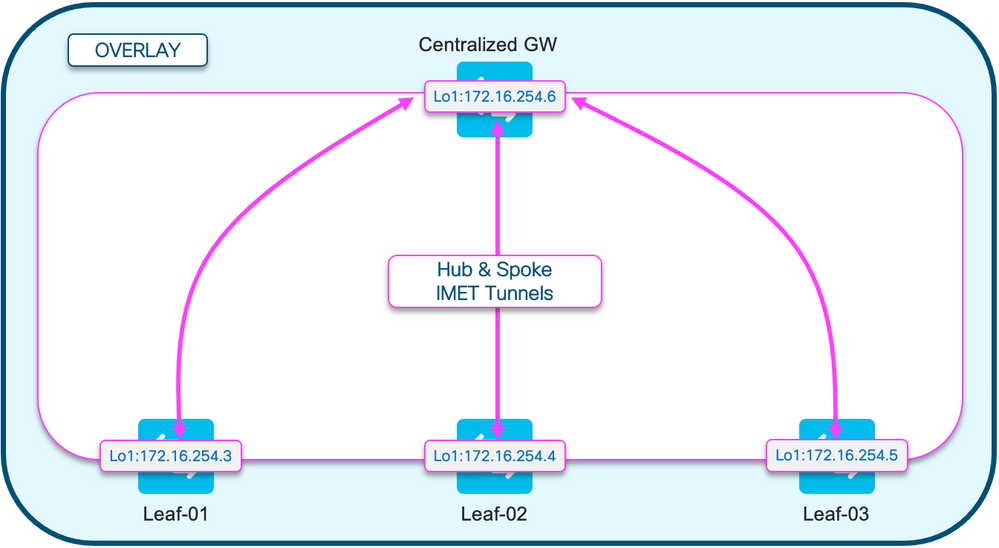
Diagrama Route-Type 3 (RT3)
Este diagrama muestra el diseño radial de los túneles de difusión IMET (RT3)

Nota: La transmisión radial es necesaria para evitar que los folletos con el mismo segmento se envíen difusión entre sí directamente.
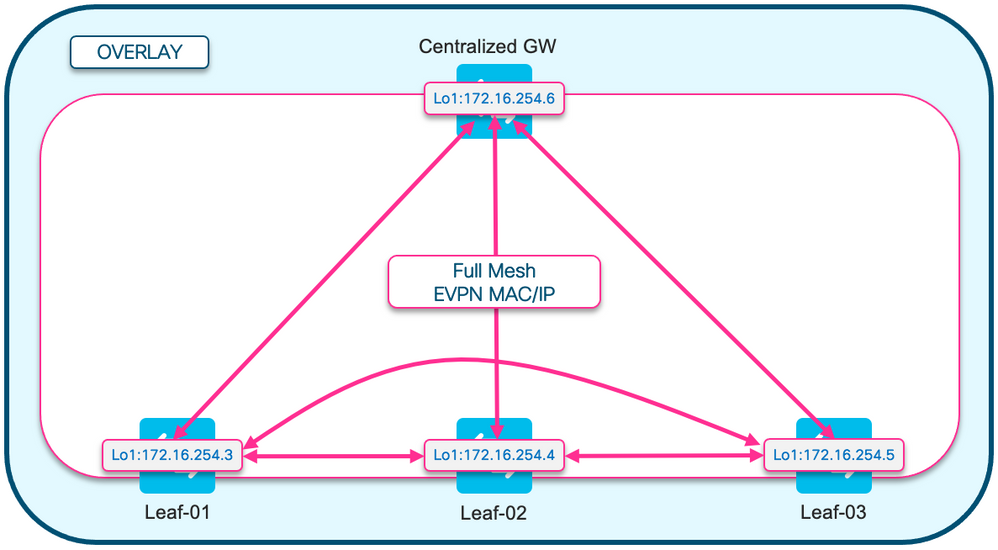
Diagrama de resolución de direcciones (ARP)
Este diagrama demuestra que ARP no puede alcanzar ningún host en el mismo segmento EPVN. Cuando el host ARPs para otro host, sólo el CGW obtiene este ARP y responde
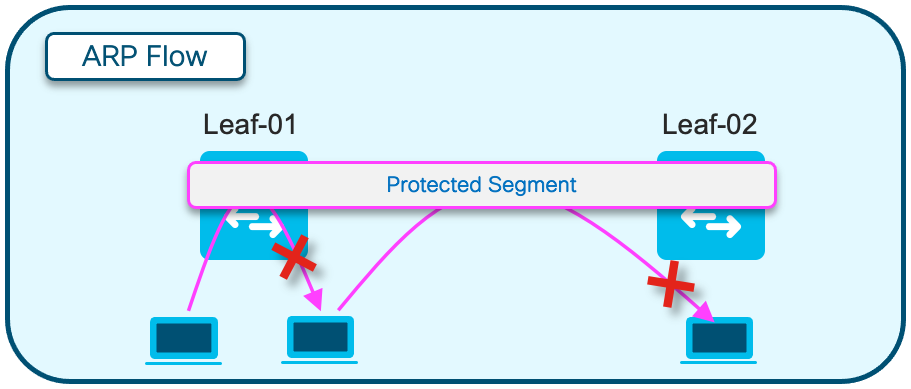

Nota: El uso de la palabra clave 'protected' crea instancias de este cambio de comportamiento ARP.
Ejemplo: member evpn-instance 202 vni 20201 protected
Configurar (Totalmente aislado)
Diagrama de la red
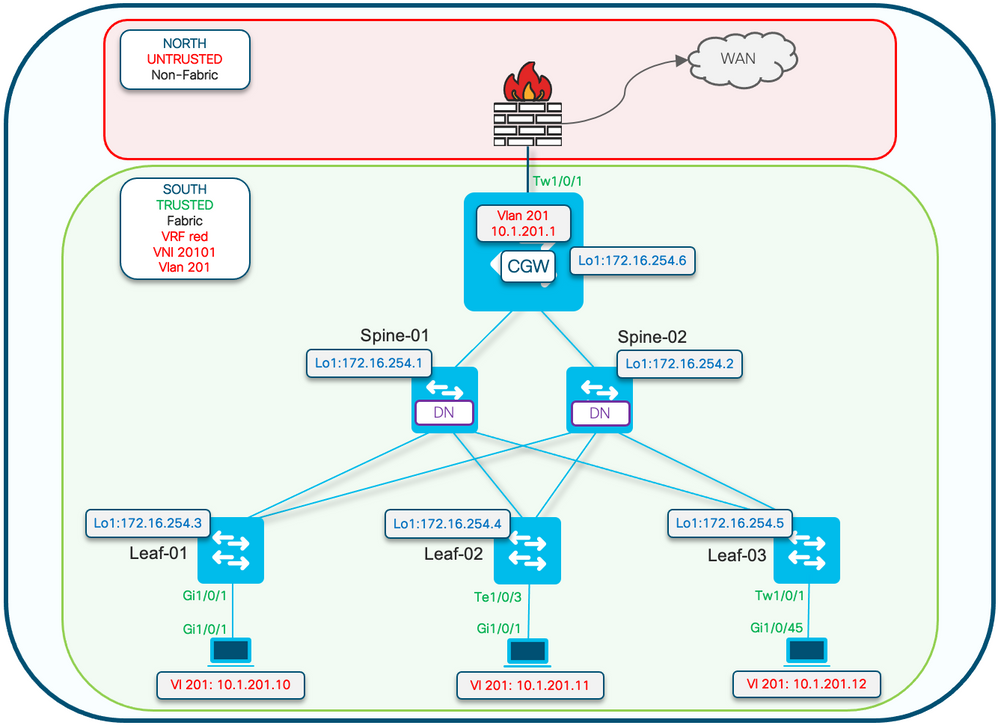
La palabra clave Protected configuration se aplica en los switches Leaf. El CGW es un dispositivo promiscuo e instala todas las direcciones MAC.

Nota: La lista de comunidad de política de ruteo y la configuración de route-map que controla la importación/exportación de prefijos IMET se muestra en Implementación de la Política de Ruteo BGP EVPN en los Catalyst 9000 Series Switches. En este documento sólo se muestran las diferencias de segmentos protegidos.
Leaf-01 (configuración de EVPN base)
Leaf-01#show run | sec l2vpn
l2vpn evpn
replication-type static
flooding-suppression address-resolution disable <-- Disables ARP caching so ARP is always sent up to the CGW
router-id Loopback1
l2vpn evpn instance 201 vlan-based encapsulation vxlan replication-type ingress <-- Sets segment to use Unicast replication of BUM traffic via RT3 type BGP routes multicast advertise enable
Leaf01#show run | sec vlan config vlan configuration 201 member evpn-instance 201 vni 20101 protected <-- protected keyword added
CGW (configuración básica)
CGW#show running-config | beg l2vpn evpn instance 201 l2vpn evpn instance 201 vlan-based encapsulation vxlan replication-type ingress default-gateway advertise enable <-- adds the BGP attribute EVPN DEF GW:0:0 to the MAC/IP prefix multicast advertise enable
CGW#show running-config | sec vlan config vlan configuration 201
member evpn-instance 201 vni 20101
CGW#show run int nve 1 Building configuration... Current configuration : 313 bytes ! interface nve1 no ip address source-interface Loopback1 host-reachability protocol bgp
member vni 20101 ingress-replication local-routing <-- 'ingress-replication' (Unicast all BUM traffic) / 'local-routing' (Enables vxlan centralized gateway forwarding)
CGW#show run interface vlan 201 Building configuration... Current configuration : 231 bytes ! interface Vlan201 mac-address 0000.beef.cafe <-- MAC is static in this example for viewing simplicity. This is not required vrf forwarding red <-- SVI is in VRF red ip address 10.1.201.1 255.255.255.0 no ip redirects ip local-proxy-arp <-- Sets CGW to Proxy reply even for local subnet ARP requests ip pim sparse-mode ip route-cache same-interface <-- This is auto added when local-proxy-arp is configured. However, this is a legacy 'fast switching' command that is not used by CEF & is not required for forwarding ip igmp version 3 no autostate

Nota: En el CGW no se aplica ninguna política BGP. El CGW puede recibir y enviar todos los tipos de prefijo (RT2, RT5 / RT3).
Verificar (totalmente aislado)
Detalles de EVI
Leaf01#sh l2vpn evpn evi 201 detail
EVPN instance: 201 (VLAN Based)
RD: 172.16.254.3:201 (auto)
Import-RTs: 65001:201
Export-RTs: 65001:201
Per-EVI Label: none
State: Established
Replication Type: Ingress
Encapsulation: vxlan
IP Local Learn: Enabled (global)
Adv. Def. Gateway: Disabled (global)
Re-originate RT5: Disabled
Adv. Multicast: Enabled
AR Flood Suppress: Disabled (global)
Vlan: 201
Protected: True (local access p2p blocked) <-- Vlan 201 is in protected mode
<...snip...>
Generación de RT2 local (host local a RT2)
Verifique la cadena de dependencia de componentes desde el aprendizaje del host local hasta la generación RT2:
- SISF (Mientras que la hoja no tiene una SVI, SISF todavía obtiene la información del host a través de la trama ARP del host)
- Gestor de EVPN
- L2RIB
- BGP

Consejo: Si un componente anterior no está correctamente programado, toda la cadena de dependencias se rompe (ejemplo: SISF no tiene una entrada en, entonces BGP no puede crear un RT2).
SISF
Verifique que SISF tenga el host aprendido en la base de datos (la información del host aprendida de DHCP o ARP)
- El SISF aprende las entradas MAC del aprendizaje IOS-MATM y luego las envía al EVPN Mgr (debe ser MAC-REACHABLE con la política "evpn-sisf-policy")
- SISF obtiene un enlace IP/MAC en un VTEP local y usando el administrador EVPN esa información se espera que sea programada como una ruta /32 vía BGP a otras hojas.

Nota: En este escenario, el host tiene una IP estática, por lo que SISF utiliza ARP para obtener los detalles del host. En la sección Mayormente aislado se muestra la indagación DHCP y DHCP.
Leaf01#show device-tracking database vlanid 201
vlanDB has 1 entries for vlan 201, 1 dynamic
Codes: L - Local, S - Static, ND - Neighbor Discovery, ARP - Address Resolution Protocol, DH4 - IPv4 DHCP, DH6 - IPv6 DHCP, PKT - Other Packet, API - API created
Preflevel flags (prlvl):
0001:MAC and LLA match 0002:Orig trunk 0004:Orig access
0008:Orig trusted trunk 0010:Orig trusted access 0020:DHCP assigned
0040:Cga authenticated 0080:Cert authenticated 0100:Statically assigned
Network Layer Address Link Layer Address Interface vlan prlvl age state Time left
ARP 10.1.201.10 0006.f601.cd43 Gi1/0/1 201 0005 3mn REACHABLE 86 s <-- Gleaned from local host ARP Request
Administrador de EVPN
EVPN Gestor aprende MAC local e instala en L2RIB. EVPN Gestor también aprende el MAC remoto de L2RIB, pero la entrada se utiliza solamente para procesar la movilidad MAC
Confirmar que el EVPN Mgr se actualiza con la entrada SISF
Leaf01#show l2vpn evpn mac evi 201 MAC Address EVI VLAN ESI Ether Tag Next Hop(s) -------------- ----- ----- ------------------------ ---------- --------------- 0006.f601.cd43 201 201 0000.0000.0000.0000.0000 0 Gi1/0/1:201 <-- MAC in VLan 201 local interface Gi1/0/1:service instance 201 <...snip...>
L2RIB
- L2RIB aprende el MAC local de EVPN Mgr y lo envía a BGP y L2FIB
- L2RIB también es responsable de aprender MAC remotos de BGP para actualizar EVPN Mgr y L2FIB.
- L2RIB necesita tanto local como remoto para que otros componentes se actualicen correctamente.
- El componente L2RIB se sitúa entre el aprendizaje MAC local y remoto en función de la dirección/componente que se debe actualizar
conservado
Verifique que L2RIB esté actualizado con el MAC local del EVPN Mgr
Leaf01#show l2route evpn mac topology 201 <-- View the overall topology for this segment EVI ETag Prod Mac Address Next Hop(s) Seq Number ----- ---------- ----- -------------- ---------------------------------------------------- ---------- 201 0 BGP 0000.beef.cafe V:20101 172.16.254.6 0 <-- produced by BGP who updated L2RIB (remote learn) 201 0 L2VPN 0006.f601.cd43 Gi1/0/1:201 0 <-- produced by EVPN Mgr who updated L2RIB (local learn) Leaf01#show l2route evpn mac mac-address 0006.f601.cd43 detail EVPN Instance: 201 Ethernet Tag: 0 Producer Name: L2VPN <-- Produced by local MAC Address: 0006.f601.cd43 <-- Host MAC Address Num of MAC IP Route(s): 1 Sequence Number: 0 ESI: 0000.0000.0000.0000.0000 Flags: B() Next Hop(s): Gi1/0/1:201 (E-LEAF) <-- Port:Instance and info about the Role (Leaf)
BGP
Verificar que L2RIB actualice BGP
Leaf01#show bgp l2vpn evpn route-type 2 0 0006.f601.cd43 *
BGP routing table entry for [2][172.16.254.3:201][0][48][0006F601CD43][0][*]/20, version 268232
Paths: (1 available, best #1, table evi_201) <-- In the totally isolated evi context
Advertised to update-groups:
2
Refresh Epoch 1
Local
0.0.0.0 (via default) from 0.0.0.0 (172.16.255.3) <-- from 0.0.0.0 indicates local
Origin incomplete, localpref 100, weight 32768, valid, sourced, local, best <-- also indicates local
EVPN ESI: 00000000000000000000, Label1 20101
Extended Community: RT:65001:201 ENCAP:8 EVPN E-Tree:flag:1,label:0 <-- EVPN e-Tree attribute with Leaf flag = 1 (added to indicate this is a host address)
Local irb vxlan vtep:
vrf:not found, l3-vni:0
local router mac:0000.0000.0000
core-irb interface:(not found)
vtep-ip:172.16.254.3 <-- Local VTEP Loopback
rx pathid: 0, tx pathid: 0x0
Updated on Sep 14 2023 20:16:17 UTC
Aprendizaje de RT2 remoto (gateway predeterminado RT2)
BGP
Verifique que BGP haya aprendido el prefijo CGW RT2
Leaf01#show bgp l2vpn evpn route-type 2 0 0000.beef.cafe 10.1.201.1
BGP routing table entry for [2][172.16.254.3:201][0][48][0000BEEFCAFE][32][10.1.201.1]/24, version 114114
Paths: (1 available, best #1, table evi_201) <-- EVI context is 201
Flag: 0x100
Not advertised to any peer
Refresh Epoch 2
Local, imported path from [2][172.16.254.6:201][0][48][0000BEEFCAFE][32][10.1.201.1]/24 (global)
172.16.254.6 (metric 3) (via default) from 172.16.255.1 (172.16.255.1)
Origin incomplete, metric 0, localpref 100, valid, internal, best
EVPN ESI: 00000000000000000000, Label1 20101 <-- Correct segment identifier
Extended Community: RT:65001:201 ENCAP:8 EVPN DEF GW:0:0 <-- Default gateway attribute is added via the 'default gateway advertise CLI'
Originator: 172.16.255.6, Cluster list: 172.16.255.1
rx pathid: 0, tx pathid: 0x0
Updated on Sep 1 2023 15:27:45 UTC
L2RIB
Verificar L2RIB actualizado de BGP
- L2RIB aprende el MAC local de EVPN Mgr y lo envía a BGP y L2FIB. L2RIB también es responsable de aprender MAC remotos de BGP para actualizar EVPN Mgr y L2FIB.
- L2RIB necesita tanto local como remoto para que otros componentes se actualicen correctamente.
- El componente L2RIB se sitúa entre el aprendizaje MAC local y remoto dependiendo de la dirección y el componente que se debe actualizar.conservado
Leaf01#show l2route evpn default-gateway host-ip 10.1.201.1 EVI ETag Prod Mac Address Host IP Next Hop(s) ----- ---------- ----- -------------- --------------------------------------- -------------------------------------------------- 201 0 BGP 0000.beef.cafe 10.1.201.1 V:20101 172.16.254.6 <-- L2RIB has the MAC-IP of the Gateway programmed
L2FIB
Verificar en L2FIB
- Componente responsable de actualizar FED con los MAC para programar en hardware.
- Las entradas MAC remotas instaladas por L2FIB en FED-MATM NO se puntean en IOS-MATM. (IOS-MATM muestra sólo MAC locales, mientras que FED-MATM muestra tanto MAC local como remoto)
- La salida L2FIB solo muestra los MAC remotos (no es responsable de programar los MAC locales).
Leaf01#show l2fib bridge-domain 201 address unicast 0000.beef.cafe MAC Address : 0000.beef.cafe <-- CGW MAC Reference Count : 1 Epoch : 0 Producer : BGP <-- Learned from BGP Flags : Static Adjacency : VXLAN_UC PL:2973(1) T:VXLAN_UC [MAC]20101:172.16.254.6 <-- CGW Loopback IP PD Adjacency : VXLAN_UC PL:2973(1) T:VXLAN_UC [MAC]20101:172.16.254.6 Packets : 6979 Bytes : 0
FED
Verificar en FED MATM
- En el nivel de hardware de las Hojas configuradas con la 'palabra clave protected' sólo debería ver la MAC de gateway predeterminada CGW y las MAC de host local.
- El switch observa el prefijo RT2 para el atributo DEF GW para determinar qué MAC remoto es elegible para instalar.
Leaf01#show platform software fed switch active matm macTable vlan 201
VLAN MAC Type Seq# EC_Bi Flags machandle siHandle riHandle diHandle *a_time *e_time ports Con ------------------------------------------------------------------------------------------------------------------------------------------------------------------------------------------------------------------------------ 201 0000.beef.cafe 0x5000001 0 0 64 0x7a199d182498 0x7a199d183578 0x71e059173e08 0x0 0 82 VTEP 172.16.254.6 adj_id 9 No
<-- Only remote MAC installed in Fed is the Default Gateway (0x5000001 type) Conn = No (meaning not directly connected) 201 0006.f601.cd01 0x1 2458 0 0 0x7a199d1a2248 0x7a199d19eef8 0x0 0x7a199c6f7cd8 300 2 GigabitEthernet1/0/1 Yes 201 0006.f601.cd43 0x1 8131 0 0 0x7a199d195a98 0x7a199d19eef8 0x0 0x7a199c6f7cd8 300 84 GigabitEthernet1/0/1
<-- Two local MAC addresses (0x1 type) Conn = Yes (directly connected)
Total Mac number of addresses:: 5 Summary: Total number of secure addresses:: 0 Total number of drop addresses:: 0 Total number of lisp local addresses:: 0 Total number of lisp remote addresses:: 3 *a_time=aging_time(secs) *e_time=total_elapsed_time(secs) Type: MAT_DYNAMIC_ADDR 0x1 MAT_STATIC_ADDR 0x2 MAT_CPU_ADDR 0x4 MAT_DISCARD_ADDR 0x8 MAT_ALL_VLANS 0x10 MAT_NO_FORWARD 0x20 MAT_IPMULT_ADDR 0x40 MAT_RESYNC 0x80 MAT_DO_NOT_AGE 0x100 MAT_SECURE_ADDR 0x200 MAT_NO_PORT 0x400 MAT_DROP_ADDR 0x800 MAT_DUP_ADDR 0x1000 MAT_NULL_DESTINATION 0x2000 MAT_DOT1X_ADDR 0x4000 MAT_ROUTER_ADDR 0x8000 MAT_WIRELESS_ADDR 0x10000 MAT_SECURE_CFG_ADDR 0x20000 MAT_OPQ_DATA_PRESENT 0x40000 MAT_WIRED_TUNNEL_ADDR 0x80000 MAT_DLR_ADDR 0x100000 MAT_MRP_ADDR 0x200000 MAT_MSRP_ADDR 0x400000 MAT_LISP_LOCAL_ADDR 0x800000 MAT_LISP_REMOTE_ADDR 0x1000000 MAT_VPLS_ADDR 0x2000000 MAT_LISP_GW_ADDR 0x4000000
<-- the addition of these values = 0x5000001
MAT_LISP_REMOTE_ADDR 0x1000000
MAT_LISP_GW_ADDR 0x4000000
MAT_DYNAMIC_ADDR 0x1
Adyacencia del plano de datos
Como paso final después de confirmar la entrada FED, puede resolver el índice de reescritura (RI)
Leaf01#sh platform hardware fed switch active fwd-asic abstraction print-resource-handle 0x71e059173e08 0
<-- 0x71e059173e08 is taken from previous FED command riHandle for the CGW MAC Handle:0x71e059173e08 Res-Type:ASIC_RSC_RI Res-Switch-Num:255 Asic-Num:255 Feature-ID:AL_FID_L2_WIRELESS Lkp-ftr-id:LKP_FEAT_INVALID ref_count:1 priv_ri/priv_si Handle: 0x71e05917b8d8Hardware Indices/Handles: index0:0x38 mtu_index/l3u_ri_index0:0x0 index1:0x38 mtu_index/l3u_ri_index1:0x0 Features sharing this resource:58 (1)] Brief Resource Information (ASIC_INSTANCE# 0) ---------------------------------------- ASIC#:0 RI:56 Rewrite_type:AL_RRM_REWRITE_LVX_IPV4_L2_PAYLOAD_ENCAP_EPG(116) Mapped_rii:LVX_L3_ENCAP_L2_PAYLOAD_EPG(137) Src IP: 172.16.254.3 <-- source tunnel IP Dst IP: 172.16.254.6 <-- dest tunnel IP iVxlan dstMac: 0x9db:0x00:0x00 iVxlan srcMac: 0x00:0x00:0x00 IPv4 TTL: 0 iid present: 0 lisp iid: 20101 <-- Segment 20101 lisp flags: 0 dst Port: 4789 <-- VxLAN update only l3if: 0 is Sgt: 0 is TTL Prop: 0 L3if LE: 53 (0) Port LE: 281 (0) Vlan LE: 8 (0)

Nota: También puede utilizar 'show platform software fed switch active matm macTable vlan 201 detail' que encadena este comando con el comando FED en un resultado
Configurar (parcialmente aislado)
Diagrama de la red
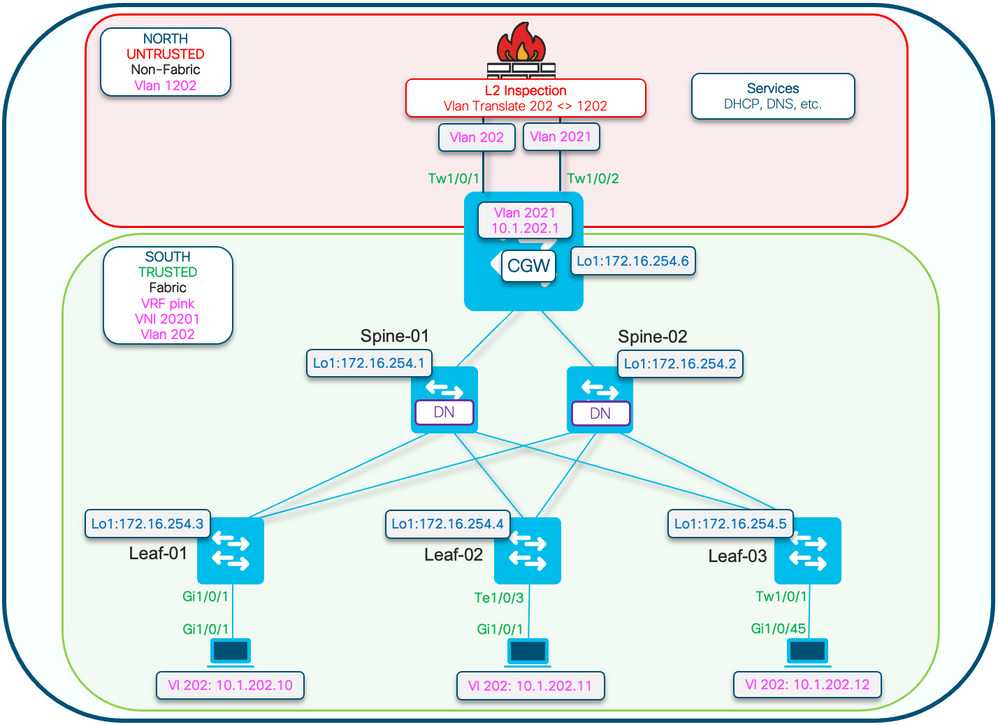
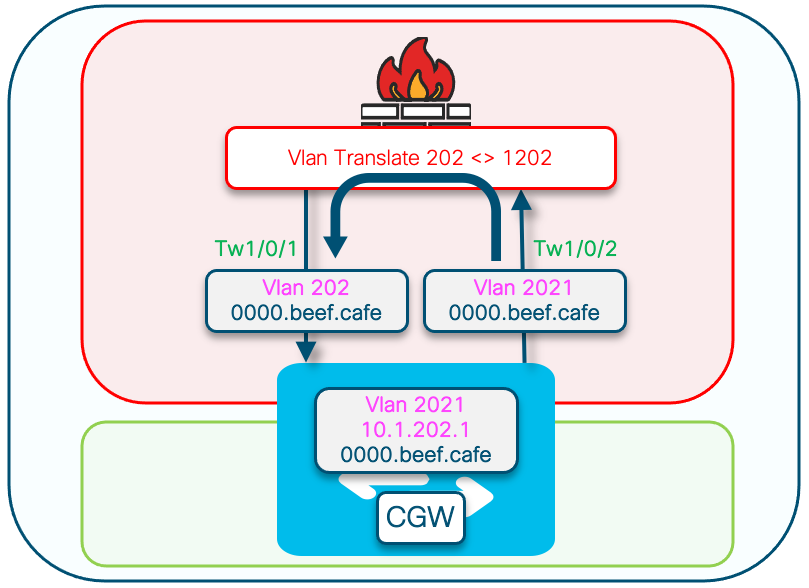

Nota: En esta sección sólo se tratan las diferencias de segmentos totalmente aislados.
- Routing-policy para marcar la dirección IP MAC del gateway GCW con el atributo DEF GW
- Política de seguimiento de dispositivos personalizados necesaria para evitar los flaps de MAC
- Enlace estático de seguimiento de dispositivos para IP MAC GW
Leaf-01 (configuración de EVPN base)
Leaf-01#show run | sec l2vpn
l2vpn evpn
replication-type static
flooding-suppression address-resolution disable <-- Disables ARP caching so ARP is always sent up to the CGW
router-id Loopback1 l2vpn evpn instance 202 vlan-based encapsulation vxlan replication-type ingress multicast advertise enable
Leaf01#show run | sec vlan config vlan configuration 202 member evpn-instance 202 vni 20201 protected <-- protected keyword added
CGW (configuración básica)
Establezca el modo de replicación en nve
CGW#show run int nve 1 Building configuration... Current configuration : 313 bytes ! interface nve1 no ip address source-interface Loopback1 host-reachability protocol bgp member vni 20201 ingress-replication local-routing <-- 'ingress-replication' (Unicast all BUM traffic) / 'local-routing' (Enables vxlan centralized gateway forwarding) end
Configuración de la SVI del gateway externo
CGW#show run interface vlan 2021 Building configuration... Current configuration : 231 bytes ! interface Vlan2021 mac-address 0000.beef.cafe <-- MAC is static in this example for viewing simplicity. This is not required vrf forwarding pink <-- SVI is in VRF pink ip address 10.1.202.1 255.255.255.0 no ip redirects ip local-proxy-arp <-- Sets CGW to Proxy reply even for local subnet ARP requests ip pim sparse-mode ip route-cache same-interface <-- This is auto added when local-proxy-arp is configured. However, this is a legacy 'fast switching' command that is not used by CEF & is not required for forwarding ip igmp version 3 no autostate end
Crear una política con la limpieza desactivada
device-tracking policy dt-no-glean <-- Configure device tracking policy to prevent MAC-IP flapping security-level glean no protocol ndp no protocol dhcp6 no protocol arp no protocol dhcp4
Adjuntar a externalgatewayevi/vlan
CGW#show running-config | sec vlan config vlan configuration 202 member evpn-instance 202 vni 20201
device-tracking attach-policy dt-no-glean <-- apply the new device tracking policy to the vlan configuration
Agregar entradas estáticas a la tabla de seguimiento de dispositivos para mac-ip de gateway externo
device-tracking binding vlan 202 10.1.202.1 interface TwentyFiveGigE1/0/1 0000.beef.cafe
<-- All static entries in device tracking table should be for external gateway mac-ip’s.
If there is any other static entry in device tracking table, match ip/ipv6 configurations in route map with prefix lists (permit/deny) are required to attach default gateway extended community to external gateway mac-ip routes only.
Cree el route map BGP para que coincida con los prefijos RT2 MAC-IP y establezca la comunidad ampliada del gateway predeterminado
route-map CGW_DEF_GW permit 10
match evpn route-type 2-mac-ip <-- match RT2 type MAC-IP
set extcommunity default-gw <-- Set Default-gateway (DEF GW 0:0) extended community
route-map CGW_DEF_GW permit 20
Aplique route-map a los vecinos BGP Route Reflector
CGW#sh run | s r bgp
address-family l2vpn evpn
neighbor 172.16.255.1 activate
neighbor 172.16.255.1 send-community both
neighbor 172.16.255.1 route-map CGW_DEF_GW out <-- Sets the DEF GW Community when it advertises MAC-IP type RT2 to the RR
neighbor 172.16.255.2 activate
neighbor 172.16.255.2 send-community both
neighbor 172.16.255.2 route-map CGW_DEF_GW out <-- Sets the DEF GW Community when it advertises MAC-IP type RT2 to the RR
Verificar (parcialmente aislado)
Detalles de EVI
Leaf01#show l2vpn evpn evi 202 detail
EVPN instance: 202 (VLAN Based)
RD: 172.16.254.3:202 (auto)
Import-RTs: 65001:202
Export-RTs: 65001:202
Per-EVI Label: none
State: Established
Replication Type: Ingress
Encapsulation: vxlan
IP Local Learn: Enabled (global)
Adv. Def. Gateway: Enabled (global)
Re-originate RT5: Disabled
Adv. Multicast: Enabled
Vlan: 202
Protected: True (local access p2p blocked) <-- Vlan 202 is in protected mode
<...snip...>
Generación de RT2 local (host local a RT2)
Cubierto en el anterior ejemplo Totalmente aislado
Aprendizaje de RT2 remoto (gateway predeterminado RT2)
Describe las diferencias de Totally Isolated
Prefijo de gateway predeterminado CGW (hoja)
Verifique que el prefijo tenga el atributo apropiado para ser elegible para ser instalado en el hardware

Nota: Esto es crítico para que la retransmisión DHCP L2 funcione
Leaf01#show bgp l2vpn evpn route-type 2 0 0000.beef.cafe 10.1.202.1
BGP routing table entry for [2][172.16.254.3:202][0][48][0000BEEFCAFE][32][10.1.202.1]/24, version 184602
Paths: (1 available, best #1, table evi_202) <-- the EVI context of 202 which matches the Vlan/EVI we are concerned about
Not advertised to any peer
Refresh Epoch 2
Local, imported path from [2][172.16.254.6:202][0][48][0000BEEFCAFE][32][10.1.202.1]/24 (global)
172.16.254.6 (metric 3) (via default) from 172.16.255.1 (172.16.255.1)
Origin incomplete, metric 0, localpref 100, valid, internal, best
EVPN ESI: 00000000000000000000, Label1 20201 <-- Correct Segment ID
Extended Community: RT:65001:202 ENCAP:8 EVPN DEF GW:0:0 <-- prefix has the Default GW attribute added
Originator: 172.16.255.6, Cluster list: 172.16.255.1
rx pathid: 0, tx pathid: 0x0
Updated on Sep 7 2023 19:56:43 UTC
FED MATM (hoja)
F241.03.23-9300-Leaf01#show platform software fed active matm macTable vlan 202 mac 0000.beef.cafe VLAN MAC Type Seq# EC_Bi Flags machandle siHandle riHandle diHandle *a_time *e_time ports Con ------------------------------------------------------------------------------------------------------------------------------------------------------------------------------------------------------------------------------ 202 0000.beef.cafe 0x5000001 0 0 64 0x71e058da7858 0x71e05916c0d8 0x71e059171678 0x0 0 5 VTEP 172.16.254.6 adj_id 651 No
<-- MAC of Default GW is installed in FED
SISF (CGW)
CGW#sh device-tracking database vlanid 202
vlanDB has 1 entries for vlan 202, 0 dynamic
Codes: L - Local, S - Static, ND - Neighbor Discovery, ARP - Address Resolution Protocol, DH4 - IPv4 DHCP, DH6 - IPv6 DHCP, PKT - Other Packet, API - API created
Preflevel flags (prlvl):
0001:MAC and LLA match 0002:Orig trunk 0004:Orig access
0008:Orig trusted trunk 0010:Orig trusted access 0020:DHCP assigned
0040:Cga authenticated 0080:Cert authenticated 0100:Statically assigned
Network Layer Address Link Layer Address Interface vlan prlvl age state Time left
S 10.1.202.1 0000.beef.cafe Twe1/0/1 202 0100 13006mn STALE N/A
IOS MATM (CGW)
CGW#show mac address-table address 0000.beef.cafe
Mac Address Table
-------------------------------------------
Vlan Mac Address Type Ports
---- ----------- -------- -----
201 0000.beef.cafe STATIC Vl201
2021 0000.beef.cafe STATIC Vl2021 <-- The Vlan 2021 SVI MAC advertised out Tw1/0/1
202 0000.beef.cafe DYNAMIC Twe1/0/1 <-- The Vlan 2021 SVI MAC learned dynamically after passing through the Firewall and the Dot1q tag swapped to fabric Vlan 202
Troubleshoot
Resolución de direcciones (ARP)
Pasos generales para aislar los problemas ARP
- Confirmar que el túnel IMET está listo
- Captura en enlace ascendente CGW para verificar que ARP recibido encapsulado desde hoja
- Si no se ve que ARP llega, encap en uplink
- Verifique que el túnel IMET esté listo tanto en la hoja como en CGW
- Captura en enlaces ascendentes de hoja para confirmar que el ARP se encapsula y envía
- Solucionar problemas de ruta intermedia
- Si ARP llega a la captura de túnel IMET de borde pero no está programado en la tabla VRF ARP
- Solucione los problemas de ruta de punt CPU/CoPP para confirmar ARP punted a CPU
- Confirme que la dirección IP/información del cliente es correcta
- Debug ARP en VRF para ver qué podría estar impactando el proceso ARP
- Verifique que CGW MAC esté instalado como next hop/dest mac en los hosts
- Confirmar CGW tiene ambas entradas ARP con los MACs host reales
- Verificar que la política de firewall permita este tipo de tráfico

Precaución: Tenga cuidado al habilitar las depuraciones.
Asegúrese de que ha desactivado la supresión de inundaciones
Leaf-01#show run | sec l2vpn
l2vpn evpn
replication-type static
flooding-suppression address-resolution disable <-- This CLI prevents a VTEP from trying to unicast other VTEPs based on its EVPN table
Cuando el host de Leaf-02 resuelve ARP para el host de Leaf-01, la solicitud ARP no se transmite directamente a Leaf-01
- El ARP en cambio pasa por el único túnel BUM programado en Leaf-02 hacia el CGW
- El CGW no reenvía esto a Leaf-01, y en cambio responde con su propio MAC
- Esto hace que todas las comunicaciones pasen al CGW y luego se enruten entre los hosts
- CGW enruta los paquetes, incluso cuando están en la misma subred local
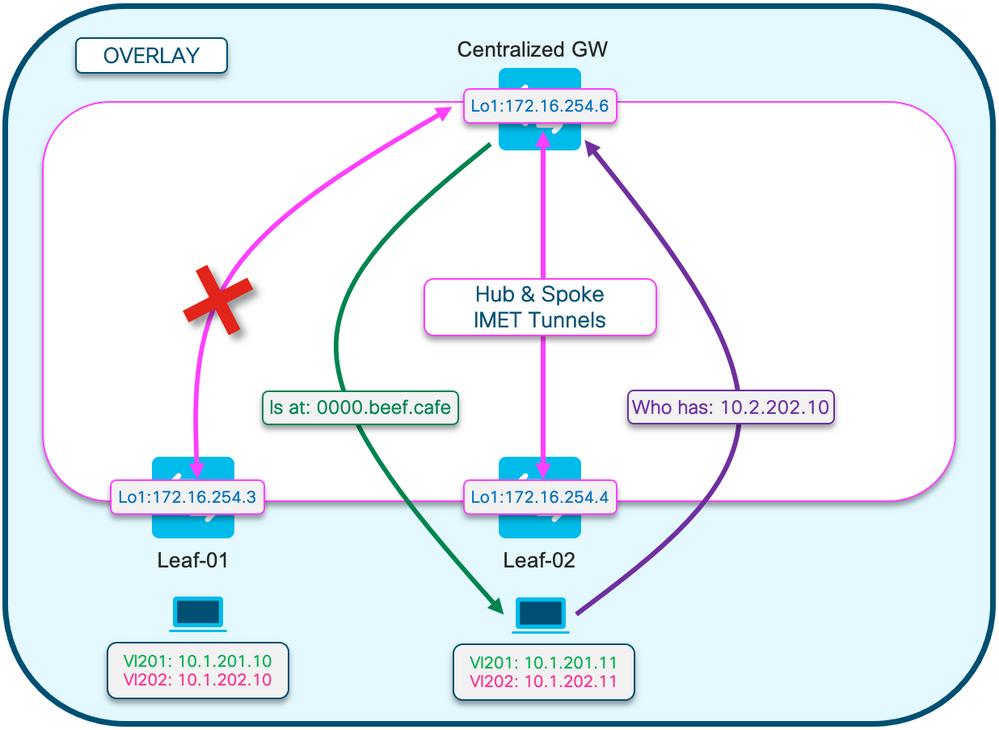
Este diagrama es para ayudar a visualizar el flujo del proceso de resolución ARP descrito en esta sección.
La solicitud ARP se muestra en color morado
- Esta solicitud ARP es para resolver la dirección MAC del host 10.1.202.10 fuera de Leaf-01
- Observe que la línea púrpura termina en CGW y no llega a Leaf-01
La respuesta ARP se muestra en verde
- La respuesta contiene el MAC de CGW SVI para Vlan 202
- Observe que la línea verde proviene del CGW, no del host real

Nota: La X roja indica que esta comunicación no implicó el envío de tráfico a Leaf-01.
Observe las entradas ARP en cada host respectivo
Leaf02-HOST#sh ip arp 10.1.202.10 Protocol Address Age (min) Hardware Addr Type Interface Internet 10.1.202.10 1 0000.beef.cafe ARPA Vlan202 <-- MAC address for Leaf01 host is CGW MAC Leaf01-HOST#sh ip arp 10.1.202.11 Protocol Address Age (min) Hardware Addr Type Interface Internet 10.1.202.11 7 0000.beef.cafe ARPA Vlan202 <-- MAC address for Leaf02 host is CGW MAC
Observe en CGW que se aprenden los prefijos RT2. Esto es necesario para que CGW rutee los paquetes
CGW#sh bgp l2vpn evpn route-type 2 0 0006.f617.eec4 * <-- Leaf02 actual MAC
BGP routing table entry for [2][172.16.254.6:202][0][48][0006F617EEC4][0][*]/20, version 235458
Paths: (1 available, best #1, table evi_202)
Not advertised to any peer
Refresh Epoch 2
Local, imported path from [2][172.16.254.4:202][0][48][0006F617EEC4][0][*]/20 (global)
172.16.254.4 (metric 3) (via default) from 172.16.255.1 (172.16.255.1)
Origin incomplete, metric 0, localpref 100, valid, internal, best
EVPN ESI: 00000000000000000000, Label1 20201 <-- correct segment identifier
Extended Community: RT:65001:202 ENCAP:8 EVPN E-Tree:flag:1,label:0 <-- prefix contains the Leaf flag indicating this is a normal host
Originator: 172.16.255.4, Cluster list: 172.16.255.1
rx pathid: 0, tx pathid: 0x0
Updated on Apr 9 2025 17:11:22 UTC
CGW#sh bgp l2vpn evpn route-type 2 0 0006.f601.cd44 * <-- Leaf01 actual MAC
BGP routing table entry for [2][172.16.254.6:202][0][48][0006F601CD44][0][*]/20, version 235521
Paths: (1 available, best #1, table evi_202)
Not advertised to any peer
Refresh Epoch 2
Local, imported path from [2][172.16.254.3:202][0][48][0006F601CD44][0][*]/20 (global)
172.16.254.3 (metric 3) (via default) from 172.16.255.1 (172.16.255.1)
Origin incomplete, metric 0, localpref 100, valid, internal, best
EVPN ESI: 00000000000000000000, Label1 20201 <-- correct segment identifier
Extended Community: RT:65001:202 ENCAP:8 EVPN E-Tree:flag:1,label:0 <-- prefix contains the Leaf flag indicating this is a normal host
Originator: 172.16.255.3, Cluster list: 172.16.255.1
rx pathid: 0, tx pathid: 0x0
Updated on Apr 9 2025 17:17:06 UTC
Capture el intercambio ARP en los links ascendentes para confirmar la comunicación bidireccional
- Puede utilizar Embedded Packet Capture (EPC) en los enlaces ascendentes de fabric
- Este escenario muestra EPC en el link ascendente Leaf01. Repita este mismo proceso en CGW si es necesario
Configuración del EPC
Leaf01#monitor capture 1 interface range te 1/1/2 , te 1/1/4 both match any buffer size 100 <-- both Uplinks toward fabric included
Inicie la captura
Leaf01#monitor capture 1 start
Inicie el ping para activar la solicitud ARP (en este caso, el ping es desde el host Leaf01 10.1.201.10 al host Leaf02 10.1.201.11)
Leaf01-HOST#ping vrf red 10.1.201.11
Type escape sequence to abort.
Sending 5, 100-byte ICMP Echos to 10.1.201.11, timeout is 2 seconds:
...!!
Success rate is 40 percent (2/5), round-trip min/avg/max = 1/1/1 ms
Detenga Capture & Check para las tramas ARP
Leaf01#mon cap 1 stop
F241.03.23-9300-Leaf01#show mon cap 1 buff br | i ARP
11 8.153510 00:06:f6:01:cd:42 -> ff:ff:ff:ff:ff:ff ARP 110 Who has 10.1.201.11? Tell 10.1.201.10 <-- .10 requests .11 MAC (this is Frame 11)
12 8.154030 00:00:be:ef:ca:fe -> 00:06:f6:01:cd:42 ARP 110 10.1.201.11 is at 00:00:be:ef:ca:fe <-- CGW replies with its MAC
Vea los paquetes de captura en detalle. Si desea ver más información sobre los paquetes, utilice la opción de detalle de EPC
- Tenga en cuenta que esta salida se recorta en varios lugares para obtener mayor brevedad
Leaf01#show mon cap 1 buffer detailed | beg Frame 11 <-- begin detail result from Frame 11 (ARP Request)
Frame 11: 110 bytes on wire (880 bits), 110 bytes captured (880 bits) on interface /tmp/epc_ws/wif_to_ts_pipe, id 0
Ethernet II, Src: 00:00:00:00:00:00 (00:00:00:00:00:00), Dst: 00:00:00:00:00:00 (00:00:00:00:00:00) <-- Expected to see all zeros for outbound VxLAN encapped packet
Destination: 00:00:00:00:00:00 (00:00:00:00:00:00)
Address: 00:00:00:00:00:00 (00:00:00:00:00:00)
.... ..0. .... .... .... .... = LG bit: Globally unique address (factory default)
.... ...0 .... .... .... .... = IG bit: Individual address (unicast)
Source: 00:00:00:00:00:00 (00:00:00:00:00:00)
Address: 00:00:00:00:00:00 (00:00:00:00:00:00)
.... ..0. .... .... .... .... = LG bit: Globally unique address (factory default)
.... ...0 .... .... .... .... = IG bit: Individual address (unicast)
Type: IPv4 (0x0800)
Internet Protocol Version 4, Src: 172.16.254.3, Dst: 172.16.254.6 <--- Outer tunnel IP header
Source: 172.16.254.3
Destination: 172.16.254.6
User Datagram Protocol, Src Port: 65483, Dst Port: 4789 <-- VXLAN Dest port
Virtual eXtensible Local Area Network
VXLAN Network Identifier (VNI): 20101 <-- Verify the VNI for the segment you are investigating
Reserved: 0
Ethernet II, Src: 00:06:f6:01:cd:42 (00:06:f6:01:cd:42), Dst: ff:ff:ff:ff:ff:ff (ff:ff:ff:ff:ff:ff) <-- Start of inner payload info
Type: ARP (0x0806)
Trailer: 000000000000000000000000000000000000
Address Resolution Protocol (request) <-- is an ARP request
Hardware type: Ethernet (1)
Protocol type: IPv4 (0x0800)
Hardware size: 6
Protocol size: 4
Opcode: request (1)
Sender MAC address: 00:06:f6:01:cd:42 (00:06:f6:01:cd:42) <-- Sending host
Sender IP address: 10.1.201.10
Target MAC address: 00:00:00:00:00:00 (00:00:00:00:00:00) <-- Trying to resolve MAC for host
Target IP address: 10.1.201.11
Frame 12: 110 bytes on wire (880 bits), 110 bytes captured (880 bits) on interface /tmp/epc_ws/wif_to_ts_pipe, id 0 <-- ARP reply
Ethernet II, Src: dc:77:4c:8a:6d:7f (dc:77:4c:8a:6d:7f), Dst: 68:2c:7b:f8:87:48 (68:2c:7b:f8:87:48) <-- Underlay MACs
Internet Protocol Version 4, Src: 172.16.254.6, Dst: 172.16.254.3 <-- From CGW loopback to Leaf01 loopback
User Datagram Protocol, Src Port: 65410, Dst Port: 4789
Virtual eXtensible Local Area Network
VXLAN Network Identifier (VNI): 20101
Reserved: 0
Ethernet II, Src: 00:00:be:ef:ca:fe (00:00:be:ef:ca:fe), Dst: 00:06:f6:01:cd:42 (00:06:f6:01:cd:42) <-- Start of payload
Type: ARP (0x0806)
Trailer: 000000000000000000000000000000000000
Address Resolution Protocol (reply) <-- is an ARP reply
Hardware type: Ethernet (1)
Protocol type: IPv4 (0x0800)
Hardware size: 6
Protocol size: 4
Opcode: reply (2)
Sender MAC address: 00:00:be:ef:ca:fe (00:00:be:ef:ca:fe) <-- Reply is that of the CGW MAC due to local proxy on SVI
Sender IP address: 10.1.201.11
Target MAC address: 00:06:f6:01:cd:42 (00:06:f6:01:cd:42)
Target IP address: 10.1.201.10
Prefijo de gateway CGW RT2
Falta el prefijo de gateway
Como se mencionó en la sección anterior sobre segmentos parcialmente aislados, es necesario aprender el MAC en la VLAN de fabric
- Este problema puede manifestarse si no hay tráfico destinado al gateway durante más tiempo que el temporizador de envejecimiento de MAC.
- Si falta el prefijo de la puerta de enlace CGW, debe confirmar que la dirección MAC está presente
CGW#show bgp l2vpn evpn route-type 2 0 0000.beef.cafe 10.1.202.1
% Network not in table <-- RT2 not generated on CGW
CGW#show mac address-table address 0000.beef.cafe
Mac Address Table
-------------------------------------------
Vlan Mac Address Type Ports
---- ----------- -------- -----
201 0000.beef.cafe STATIC Vl201
2021 0000.beef.cafe STATIC Vl2021
<-- MAC is not learned in Fabric Vlan 202
Total Mac Addresses for this criterion: 2
Remediación de prefijo de gateway faltante
En la mayoría de las redes de producción es probable que haya algo de tráfico en todo momento. Sin embargo, si tiene este problema, puede utilizar una de estas opciones para solucionarlo:
- Agregue entradas MAC estáticas como 'mac address-table static 0000.beef.cafe vlan 202 interface TwentyFiveGigE1/0/1'
- Aumente el temporizador de envejecimiento de MAC con 'mac address-table aging-time <seconds>'. (Tenga en cuenta que esto aumenta el tiempo de envejecimiento de todas las direcciones MAC, por lo que se prefiere la opción de MAC estático)
Falta el atributo DEF GW
Con los segmentos parcialmente aislados, existen varias configuraciones adicionales para añadir este atributo.
Falta la remediación del atributo DEF GW
Confirme estos datos:
- Está ejecutando 17.12.1 o posterior
- La CLI SISF (seguimiento de dispositivos) está presente en la configuración
- Los comandos route-map match & set se configuran y route-map se aplica a los vecinos BGP
- Ha actualizado los anuncios de BGP (debe borrar BGP para volver a anunciar el prefijo con el nuevo atributo
Roaming inalámbrico
El roaming frecuente puede hacer que BGP se actualice con demasiada frecuencia y el roaming por intervalo de tiempo debe incrementarse antes de que el switch declare que posee el MAC y envíe la actualización de RT2
- Esto ocurre cuando un host se mueve entre dos AP que están en switches diferentes.
- El límite predeterminado para la itinerancia es de 5 por 180 segundos
Leaf01#sh run | sec l2vpn
l2vpn evpn
replication-type static
flooding-suppression address-resolution disable
ip duplication limit 10 time 180 <--- You can adjust this default in the global l2vpn section
mac duplication limit 10 time 180
Leaf01#sh l2vpn evpn summary
L2VPN EVPN
EVPN Instances (excluding point-to-point): 4
VLAN Based: 4
Vlans: 4
BGP: ASN 65001, address-family l2vpn evpn configured
Router ID: 172.16.254.3
Global Replication Type: Static
ARP/ND Flooding Suppression: Disabled
Connectivity to Core: UP
MAC Duplication: seconds 180 limit 10
MAC Addresses: 13
Local: 6
Remote: 7
Duplicate: 0
IP Duplication: seconds 180 limit 10
IP Addresses: 7
Local: 4
Remote: 3
Duplicate: 0
<...snip...>
Comandos que se deben recopilar para TAC
En caso de que esta guía no haya resuelto su problema, recopile la lista de comandos mostrada y adjúntela a su solicitud de servicio del TAC.
Información mínima que se debe recopilar
(tiempo limitado para recopilar datos antes de la acción de recarga/recuperación)
conservado
- Show tech evpn
- Show tech
- Show tech sisf
conservado
Información detallada para recopilar
(Si hay tiempo para recopilar datos más completos, es preferible hacerlo)
conservado
-
show tech
-
show tech evpn
-
show tech platform evpn_vxlan switch <number>
-
show tech platform
-
show tech resource
-
show tech sisf
-
show tech isis
-
show tech bgp
-
show monitor event-trace evpn event all
-
show monitor event-trace evpn error all
-
request platform software trace archive
Información Relacionada
- Implemente la Política de Ruteo BGP EVPN en los Catalyst 9000 Series Switches
- Retransmisión de capa 2 de DHCP (próximamente)
Historial de revisiones
| Revisión | Fecha de publicación | Comentarios |
|---|---|---|
3.0 |
22-Nov-2024 |
Actualización de detalles sobre FED MATM en la tabla de terminología |
2.0 |
15-May-2024 |
Enlace agregado al documento Implementación de Retransmisión de Capa 2 DHCP BGP EVPN en Catalyst 9000 Series Switches |
1.0 |
20-Sep-2023 |
Versión inicial |
Con la colaboración de ingenieros de Cisco
- Ambrose Taylor
Contacte a Cisco
- Abrir un caso de soporte

- (Requiere un Cisco Service Contract)
 Comentarios
Comentarios